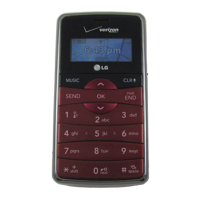
Do you have a question about the LG EnV2 and is the answer not in the manual?
| Brand | LG |
|---|---|
| Model | EnV2 |
| Category | Cell Phone |
| Language | English |
Information about the phone's rechargeable battery and its care.
Step-by-step guide to inserting a microSD card into the phone slot.
How the phone automatically protects against overheating.
Instructions for charging the phone using the provided charger.
Instructions for safely removing a microSD card from the phone.
How to check the battery status and its indicators on the screen.
How to charge the phone using a computer via USB cable.
Procedures for powering the phone on and off using internal or external keys.
Steps to make calls using the external or internal keypad.
Methods for answering incoming calls depending on phone settings.
Using voice commands for phone operations like making calls.
Managing incoming calls while already on an active call.
How to enter and save new contact details.
How to add multiple phone numbers to a single contact.
Making calls quickly using speed dial numbers.
Using single digits for quick speed dial calls.
Setting up speed dial numbers for quick calling.
Using multiple digits for speed dial calls.
Sending Text, Picture, Video, or Voice messages.
Sending picture messages with text, sound, or name cards.
Sending video messages with text, name cards, or subjects.
Sending voice messages by recording and sending audio.
Viewing and managing incoming messages.
Viewing and managing messages that have been sent.
Viewing and managing messages that have been started but not yet sent.
Managing voicemail directly from the device via a visual interface.
Basics of sending text messages using the internal keypad.
Steps to access and view messages in the inbox.
Accessing and managing voicemail messages.
Steps to access and manage the voicemail box.
Adding a new contact entry to the phone's memory.
Viewing and managing the list of saved contacts.
Accessing full-motion video clips from V CAST.
Viewing and managing videos stored in the phone.
Taking pictures directly from the phone.
Recording video messages with sound.
Accessing and downloading applications like Mobile Email and VZ Navigator.
Using GPS for directions, maps, and finding points of interest.
Viewing, taking, and trading digital pictures and videos.
Viewing and managing pictures stored in the phone.
Accessing news, sports, weather, and email via the mobile web.
Managing voicemail directly from the device via a visual interface.
Getting and managing emails on the phone.
Setting up email accounts and exchanging emails wirelessly.
Getting directions and viewing maps on the phone.
Connecting and managing Bluetooth devices like headsets.
Pairing the phone with new Bluetooth accessories.
Customizing the phone's sound settings like volume and alerts.
Customizing the phone's display screen appearance.
Designating how the phone handles incoming and outgoing calls.
Upgrading phone software to the latest version.
Customizing specific settings for phone usage.
Using voice commands for phone operations.
Locking the phone to prevent unauthorized use.
Steps for manually checking and downloading software updates.
Using voice commands for phone operations.
Securing the phone electronically to prevent unauthorized use.
Checking internal phone memory and microSD card storage.
Complete TIA Safety Information for wireless handheld phones.
Potential interference between wireless phones and hearing aids.
Warning about placing objects in the air bag deployment area.
Hazards associated with phone and battery misuse.
Guidelines for proper battery disposal, charging, and maintenance.
Warning about the risk of hearing loss from prolonged exposure to loud sounds.
Safety tips for using the wireless phone while operating a vehicle.
Information on the phone's compliance with RF energy exposure limits.
Regulations ensuring digital wireless phones are compatible with hearing aids.
Information on RF signals and FCC exposure guidelines.
Safety advice for using the phone while driving.
Precautions for using the phone near medical devices and in healthcare facilities.
Important information for safe and proper phone use to prevent damage.
Safety precautions for using the phone's charger and adapter.
Proper care and usage of the phone's antenna.
Precautions for persons with pacemakers regarding phone use.
Precautions for using the phone in areas with potentially explosive atmospheres.